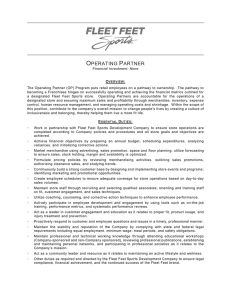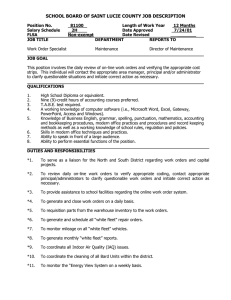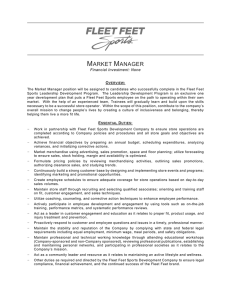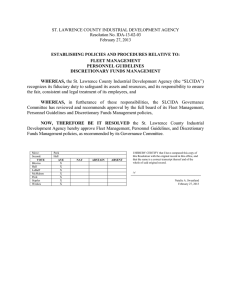Cycle Drivers In The Shipping Markets Autumn 2003
advertisement
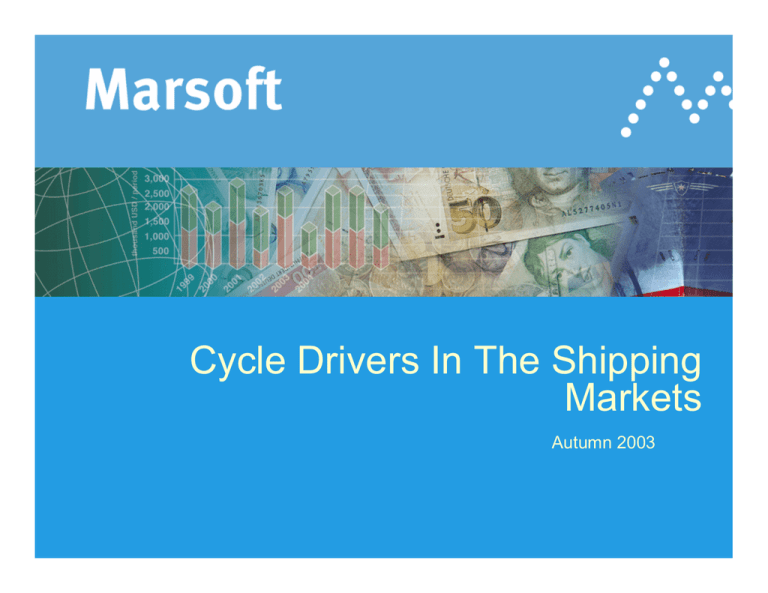
Cycle Drivers In The Shipping Markets Autumn 2003 Agenda • Historical Overview • Analysis by Market • Summary 2 Cycles Across Market Sectors (1 Year TC Rates) 30,000 25,000 $/day 20,000 15,000 10,000 5,000 0 80.1 82.1 84.1 86.1 88.1 90.1 P an am ax B ulker (69,000 dw t) 92.1 94.1 96.1 98.1 00.1 02.1 Afram ax T an ker (98,000 d w t) G eared C on tainership (1500 TE U ) 3 Performance Over Cycles 50% RoI by Market Cycle, 1980-2000 40% Bulker 30% % p.a. Tanker 20% Feeder 10% 0% -10% Strong Markets Weak Markets -20% 4 What Drives The Cycle? • Fleet Utilization Rate Is Key • Fleet Utilization Rate = Dwt Demand/Fleet Size • Fleet Size Easy To Measure • Dwt Demand More Difficult – Closely Related To Tonne-Mile Demand – Fleet Productivity Also Plays A Role 5 28,000 100 24,000 95 20,000 90 16,000 85 12,000 80 8,000 75 4,000 70 80.1 82.1 84.1 86.1 88.1 Afram ax TC Rate 90.1 92.1 94.1 96.1 98.1 00.1 Utilization Rate, % TC Rates, $/day Tanker Rates vs. Fleet Utilization 02.1 Tanker Fleet Utilization Rate 6 Key Cycle Drivers, Part 1 • Trade Demand – Linked To Economic Activity • Booms Often Followed By Busts – Other Exogenous Factors • OPEC Policies In The Early 1980s • Japanese Nuclear Power Problems In 2002 • Emergence Of China As Manufacturing Hub In 2003 • Shift From Long-Haul Middle East Oil To Short-Haul Russian Supplies Likely In 2004 7 Key Cycle Drivers, Part 2 • Fleet Developments – Over-Ordering A Perpetual Problem • Delivery Lag Of 2-3 Years Results In Delayed Feedback – Scrapping Helps Balance Market • Low Freight Rates Lead To Increased Activity • Regulations Also Have Impact 8 World Economic Growth 5 2003: C h in e s e Boom Annual GDP Growth, % 4 3 2 1 E a rly 8 0 s : G lo b a l R e c e s s io n 1 9 9 1 -9 2 : OECD R e c e s s io n 1 9 9 7 -9 8 : A s ia n C ris is 0 80 81 82 83 84 85 86 87 88 89 90 91 92 93 94 95 96 97 98 99 00 01 02 03 9 Global GDP/Trade Link Annual Growth 1990-2002 2003 (Thru Sept) Economic Growth 3.1% 3.1% Oil Trade 2.8% 4.1% Dry Bulk Trade 2.7% 5.1% Container Trade 6.5% 10.5% 10 China Becomes Global Manufacturing Hub • Takes In Large Amounts Of Raw Materials – Oil, Iron Ore, Steel Imports Soar • Adds Cheap Labor • Churns Out Huge Volume Of Finished Goods – Exports Up 34% In First Half Of 2003 (In $) • Shipping Demand Skyrockets – Bulkers & Tankers Boosted By Import Activity – Containership Market Driven By Exports 11 China Spurs Shipping Boom: Growth From 02Q1-03Q1 60% 50% 50% 40% 40% 38% 30% 20% 9% 10% 3% 2% 0% D ry B ulk Im port G row th C hina O il Im port G row th C ontainer E xport G row th R est of W orld 12 Agenda • Historical Overview • Analysis by Market – Tanker – Bulker – Containership • Summary 13 Tanker Market Cycles Post Iranian Revolution Era: 27,000 High Oil Prices 24,000 1990: Tanker Orderbook Exceeds 15% of Fleet End 1997: Orderbook Exceeds 15% of Fleet USD/Day 21,000 18,000 15,000 12,000 1999: OPEC cutbacks 1991-1992: OECD Recession 9,000 6,000 End 1985: OPEC Expands Output Oil Prices Tumble 3,000 0 1980 1982 1984 1986 1988 1990 1992 1994 1996 1998 2000 Aframax TC Rate 14 Tanker Demand 11,000 1993-2000 2% annual growth Tonne-Miles (billion) 10,000 9,000 1980-1986 (8%) annual decline 8,000 7,000 6,000 1986-1993 7% annual growth 5,000 4,000 1980 1982 1984 1986 Tanker Tonne-Miles 1988 1990 Trend '80-86 1992 1994 1996 Trend '86-93 1998 2000 Trend '93-00 15 Tanker Demand By Importing Region Other 9% Japan 15% Developing Asia 27% North America 30% OECD Europe 19% 16 Rates and Orderbook 27,000 21% 24,000 18% 15% 18,000 15,000 12% 12,000 9% 9,000 Ratios USD/Day 21,000 6% 6,000 3% 3,000 0 1980 0% 1982 1984 1986 Aframax TC Rate 1988 1990 1992 1994 1996 1998 2000 Orderbook / Fleet Ratio (right axis) 17 Scrapping Adjusts To Rates 27,000 21% 24,000 18% 15% 18,000 15,000 12% 12,000 9% 9,000 Scrapping USD/Day 21,000 6% 6,000 3% 3,000 0 0% 1980 1982 1984 1986 Aframax TC Rate 1988 1990 1992 1994 1996 1998 2000 Scrapping, as a % of Fleet (right axis) 18 Summary: Tanker Cycles • Structural Changes Instrumental in Shaping the Cycles: – Single Commodity Increases Potential For Volatility – OPEC/non-OPEC Split An Important Factor • Orderbook Provides Early Warning Signals • Scrapping as an Adjustment Mechanism – Regulatory Changes Also Affect Scrapping 19 Tanker Market Outlook • Orderbook Currently at 24% of the Fleet – Deliveries Likely to Be Very High Thru 2006 • Europe Accelerates Ban On Single-Hulls – IMO Likely To Follow Suit – High Scrapping As A Result • Fleet Likely to Grow by 2.5%/Year thru ‘05 • Can Demand Match this Pace? – Not Likely, Due To Rising Short-Haul Supplies – But China Is A Wild Card 20 Agenda • Historical Overview • Analysis by Market – Tanker – Bulker – Containership • Summary 21 Dry Bulk Market Cycles 18,000 1995: Dry Bulk Orderbook at 13% of Fleet Capacity 1983-1984 Surge in Ordering USD/Day 15,000 12,000 9,000 6,000 1998: Asian Crisis 1986-1989 Strong Economic Growth/ Limited Ordering 3,000 0 80.1 82.1 84.1 86.1 88.1 90.1 92.1 94.1 96.1 98.1 00.1 Panamax TC Rate 22 Dry Bulk Trade 10,000 Tonne-Miles (billion) 9,000 Strong Asian Imports 1980-1998 2% average annual growth 8,000 Asian Crisis 7,000 6,000 5,000 OECD Recession, Collapse of Russian Grain Imports Low Soviet Grain Imports OECD Recession 4,000 1980 1982 1984 1986 1988 1990 Dry Bulk Tonne-Miles 1992 1994 1996 1998 2000 Trend 1980-1999 23 Dry Bulk Demand By Importing Region Other 17% Developing Asia 30% North America 5% OECD Europe 26% Japan 22% 24 Dry Bulk Demand By Commodity Other 20% Steel-Related 39% Grain 15% Steam Coal 18% Steel Products 8% 25 16,000 24% 14,000 21% 12,000 18% 10,000 15% 8,000 12% 6,000 9% 4,000 6% 2,000 3% 0 0% 1980 1982 1984 1986 Panamax TC Rate 1988 1990 1992 1994 1996 1998 Ordering USD/Day Ordering Behavior 2000 Orderbook / Fleet Ratio (right axis) 26 16,000 16% 14,000 14% 12,000 12% 10,000 10% 8,000 8% 6,000 6% 4,000 4% 2,000 2% 0 0% 1980 1982 1984 1986 Panamax TC Rate 1988 1990 1992 1994 1996 1998 Scrapping USD/Day Scrapping Adjustments 2000 Scrapping, as a % of Fleet (right axis) 27 Summary: Dry Bulk Cycles • Demand Forecasts Challenging Despite Steady Long-Term Trend: – Industrial Commodities (Steel Generates ~50% Of Demand) – Energy Related Commodities (Steam Coal) – Grains and Foods • Ordering Instrumental in Shaping the Cycles: – Ordering Anticipates Demand Growth 28 Dry Bulk Market Outlook • Orderbook Currently At 14% Of Fleet Size • Fleet Growth Projected to Average 3%/Year thru 2005 • Trade Demand Projected To Grow More Slowly • China Is The Key – Slower Growth In Steel Production Expected – But Lots Of Upside Potential 29 Agenda • Historical Overview • Analysis by Market – Tanker – Bulker – Containership • Summary 30 Containership Market Cycles 1990-1995: Decline in Trade Barriers / Orderly Fleet Expansion 15,000 1999-2000: Limited Fleet Expansion USD/Day 12,000 9,000 6,000 3,000 1986-1990: Limited Fleet Growth 1995-1998: Surge of Fleet Capacity 1980-1986: Fleet Growth Outpaces Demand by 2:1 Ratio 0 80.1 82.1 84.1 86.1 88.1 90.1 92.1 94.1 96.1 98.1 00.1 TC Rate, Geared 1000 TEU Containership 31 Containership Trade (TEUs) TEUs (million) 70 1980-2000 7.2 % average annual growth 16% 14% 60 12% 50 10% 40 8% 30 6% 20 4% 10 2% 0 0% 1980 1982 1984 1986 1988 1990 Total Trade (left axis, TEUs) 1992 1994 1996 1998 Annual Growth 80 2000 1980-2000 Trend Annual Volatility (right axis) 32 Container Demand By Region Other 21% Developing Asia 25% Japan 8% North America 23% Europe 23% 33 USD/Day Ordering Behavior 16,000 40% 14,000 35% 12,000 30% 10,000 25% 8,000 20% 6,000 15% 4,000 10% 2,000 5% 0 0% 1980 1982 1984 1986 1988 1990 TC Rate, Geared 1000 TEU Feeder 1992 1994 1996 1998 2000 Orderbook / Fleet Ratio (right axis) 34 Scrapping remains Insignificant 600 Thousand TEUs 500 400 300 200 100 0 1986 1987 1988 1989 1990 1991 1992 1993 1994 1995 1996 1997 1998 1999 2000 Total Deliveries, Cellular Fleet Total Scrapping, Cellular Fleet 35 Containership Cycles: Summary • Structural Changes Play Key Role: – Trade Deregulation and Globalization – Technology (Information Systems, Large Ships, Terminals, Infrastructure) – Reshaping of Liner Industry (Deregulation/OSRA) • Ordering Instrumental in Shaping the Cycles • Scrapping Has Had Very Limited Impact 36 Containership Charter Market Outlook • Orderbook Has Risen To 30% Of Fleet Size • Fleet Growth Projected to Average 9%/Year during next 2 Years • Demand Projected To Grow By Only 7.5%/Year 37 Agenda • Historical Overview • Analysis by Market • Summary 38 Summary: Key Factors To Watch • Global Economic Growth – Is Chinese Economy Overheating? • Structural Changes – Will Protectionism Reverse Trade Gains? – OPEC vs. Russian Oil • Always Pay Attention To Orderbook – Quite High Right Now – Scrapping Will Respond To Rates/Regulations 39 Looking Ahead: Marsoft Outlook As Of 03Q4 30,000 25,000 $/day 20,000 15,000 10,000 5,000 0 80.1 82.1 84.1 86.1 88.1 P anam ax B ulker 90.1 92.1 94.1 Afram ax Tanker 96.1 98.1 00.1 02.1 04.1 1500 TE U C ontainership 40
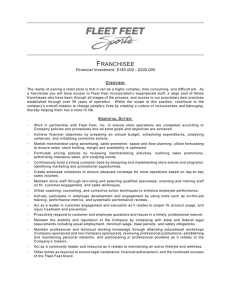
![[STORY ARCHIVES IMAGE]](http://s3.studylib.net/store/data/007416224_1-64c2a7011f134ef436c8487d1d0c1ae2-300x300.png)
